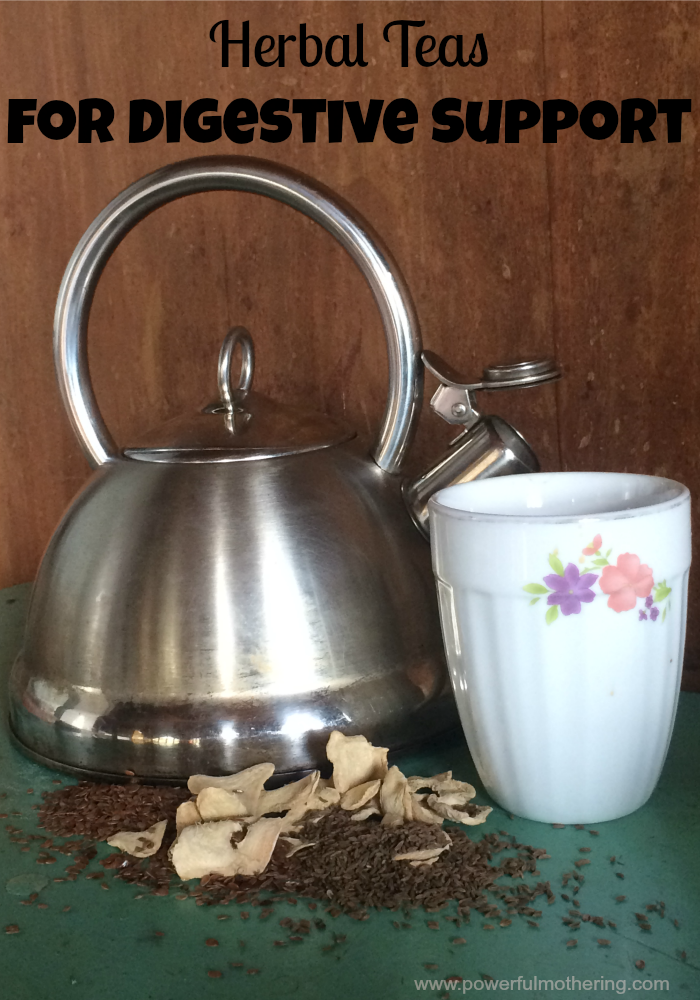This post may contain affiliate links. If you use these links to buy something we earn a commission at no extra cost to you. Powerful Mothering is supported by its audience, thankyou!
Gas, bloating and constipation is no fun! Herbs with carminative and anti-spasmodic properties can provide relief whenever digestive discomfort strikes. Homemade herbal remedies can alleviate the build up of gas, sooth and relax the intestinal tract, and serve as a mild laxative to keep things regular.
These teas are great for the whole family!
Honestly, dietary change is the best long-term solution to solve ongoing digestive issues. Food sensitivities can result in various symptoms such as gas, bloating, cramping, congestion, headaches, and even skin irritations. Playing around with diet can be quite a process, it is best to keep patient and stay attentive to the relationship between your diet and health. A food journal can be a good way to track what changes and outcomes. But for now, why not try these DIY Tummy Tea blends for immediate relief!

DIY Herbal Remedies: Tummy Teas
To relieve gas and bloating:
Carminative Seed Tea
Mix equal parts:
Ginger – antioxidant, anti-inflammatory, a carminative herb and digestive aid
Cardamom – anti-inflammatory, antispasmodic, and soothing to the digestive system
Fennel Seed – a carminative herb and digestive aid, even freshens bad breath!
Caraway Seed – popular for indigestion and flatulence, contains digestive, antioxidant and carminative properties
These are classic Ayurvedic herbs used for centuries for their soothing effects and healing benefits for the digestive system.
To relieve constipation:
Flax Seed Tea
Add 1-2 teaspoons flax seed per 1 cup hot water, let soak for up to 20 minutes and drink 1-3 times daily.
Flax provides a good source of dietary fiber that will help clean out the gut and get things moving in all the right ways. When flax seeds are soaked they produce a thick gelatinous slime that is very beneficial to the body. These seeds have a mild flavor and fun slimy texture. They act as a gentle, natural laxative soothing and hydrating the intestines as they move through the body.
Drinking flax seed tea is the easiest, quickest, and most economical solution I know of for constipation. I think it is an underrated remedy and more people should try this tea first before other measures.
Try my micronutrient rich flax crackers to get more of these helpful seeds into your diet!
Slippery Elm Bark Tea
Use 2 teaspoons (and up to 5 tablespoons) slippery elm bark per 1 cup of water. Drink as you feel necessary.
Once added to hot water, slipper elm bark produces a slippery and mucilaginous consistency similar to the flax seed. This gel is a gentle and natural laxative that nourishes and supports your GI tract. It is an herbal source of antioxidants that liberally coats the mouth, throat, stomach, and bowels with a soothing gel. The slippery elm bark tea has a delicious sweet taste and is extremely pleasing.
Slippery elm bark is a very safe herb if taken by itself but should be avoided if you are using other medications, as the mucilage can prevent proper absorption.
Unfortunately, these teas are just short-term solutions, you have to do the work to find the root of your condition. I hope these teas help you along in your journey of discovering the best foods and lifestyle adjuvants for optimum gut health. Hang in there, if you keep digging you will find the answers!
Drink Water
It can be amazing to realize digestive bouts have been caused by chronic dehydration. In addition to these teas, make sure to drink lots of water throughout the day! Before trying any remedies you should always first make sure you are drinking enough, at least half your body weight in ounces every day.
Apply an Elimination Diet
It may not immediately appeal to you but keep it in mind when you are ready for some real changes. As I mentioned earlier, dietary change is the best long-term solution to solve ongoing digestive issues
Pay attention to your diet and discover your trigger foods. Do you see patterns in your moods or physical wellbeing after eating certain foods? The idea behind an elimination is basic enough to understand; eliminate foods you think you do not react well with for a week or longer, then add one food back at a time and see the effects.
I would recommend practicing an elimination diet of the foods you think may negatively affect you. For me, this was not the easiest thing to do. I was not eager to eliminate staple foods I felt reliant upon and thought I enjoyed. But eventually, after enough chronic discomfort, I took the plunge and tried a few weeks without dairy and eggs. What do you know, I noticed a clear improvement. At first it was hard and I felt like I was missing out on culinary options, but the results are so worth it! Now I don’t even think twice about my choices. I have learned to enjoy my wellbeing more gratifying than a pleasurable taste in my mouth.
Best of luck discovering your true health and potential!
If you would like to learn more about the medicinal benefits and easy tea recipes you can make at home, check out the rest of this series on herbal teas!

Follow Primal Edge Health’s board Natural Medicine Cabinet on Pinterest.









Leave a Reply